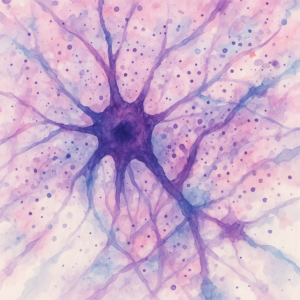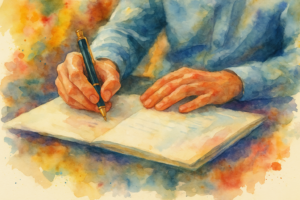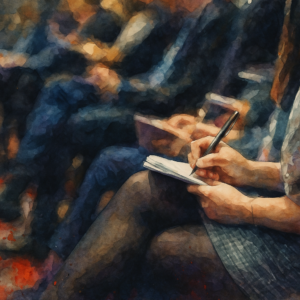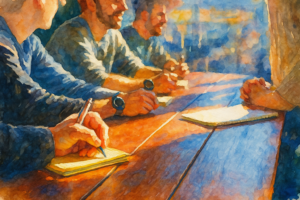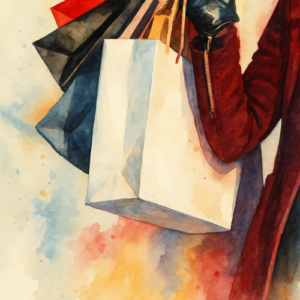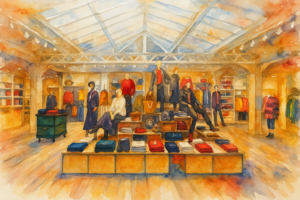Learn French with a podcast snippet! This clip is is from Vivons Heureux avant le fin de le monde podcast Numéro 1. We do not own the content. Listen to the entire episode here. The above audio sample and transcription is from Vivons Heureux avant le fin de le monde podcast Numéro 1. We do…
Take the quiz, join the conversation.
Did you find this one challenging or easy? Did you hear something diffferent? What surprised you? What levels did you complete? Comment below and share what’s opening up for you with this quiz.
Learn French with a podcast snippet! This clip is is from Vivons Heureux avant le fin de le monde podcast Numéro 1. We do not own the content. Listen to the entire episode here.
The above audio sample and transcription is from Vivons Heureux avant le fin de le monde podcast Numéro 1. We do not own the content. Listen to the entire episode here.
that slightly wrinkled appearance
What’s opening up for you with this clip? Comment below with what was surprising, easy, challenging and/or interesting.
The snippet in English
Find a translation of this snippet here, how much of this did you hear?
C’est-à-dire que vous avez d’un côté la partie intelligente de notre cerveau qui est la partie extérieure, vous savez que c’est ce qui a cet aspect un peu plissé du cerveau, qu’on voit sur toutes les les images aujourd’hui qui sont quand même assez popularisées, qui s’appelle le cortex cérébral.
In other words, on one side you have the intelligent part of our brain, which is the outer part. You know that it’s the part that has that slightly wrinkled appearance of the brain, which you can see on all the images that are quite popular today, and which is called the cerebral cortex.
The above translation from Deepl
What does “c’est-à-dire” mean?
“C’est-à-dire” means “that is to say”, “in other words”, or simply “I mean”, depending on the context. It’s used to clarify, explain, or rephrase something.
Il est intermittent, c’est-à-dire qu’il ne travaille pas en continu. (He’s intermittent, that is to say he doesn’t work continuously.)
Used to give a clearer or more familiar explanation.
Je suis végétarienne, c’est-à-dire que je ne mange pas de viande. (I’m vegetarian, in other words, I don’t eat meat.)
Helps restate something for emphasis or clarity.
C’est-à-dire ? (What do you mean?)
Used alone, it’s a quick way to ask someone to explain or elaborate.
Culturally, it’s common in both spoken and written French. In speech, it can sound formal or precise, but it’s also used conversationally to signal that you’re about to clarify or break something down.
What does “d’un côté” mean?
“D’un côté” means “on one side” or “on the one hand”, and it’s used to introduce a contrast or a division.
Vous avez d’un côté la partie intelligente de notre cerveau, et de l’autre, la partie émotionnelle. (On one side you have the intelligent part of our brain, and on the other, the emotional part.)
This use sets up a comparison between two components, often to highlight a tension, balance, or duality.
Even without completing the second half, d’un côté still suggests there’s another side to be considered—it’s a natural setup for contrasting perspectives, structures, or functions. This kind of phrasing is very common in analytical or educational French, especially in science, philosophy, or debate.
What does “cet aspect un peu plissé” mean?
“Cet aspect un peu plissé” means “that slightly wrinkled look” or “that somewhat crinkled appearance”, depending on context.
J’aime bien cet aspect un peu plissé de la jupe. (I like that slightly crinkled look of the skirt.)
Here, plissé refers to small, regular folds or wrinkles, often deliberate in fashion—like pleats or textured fabric.
Plissé can describe both intentional design (pleated clothing) and natural effects (wrinkled skin or fabric), but when softened with un peu, it often suggests something visually textured, casual, or natural-looking, not sloppy.
Culturally, in fashion, plissé can be desirable—tissu plissé refers to fine, deliberate pleating. In other settings, it might just describe something gently creased or aged, like des yeux un peu plissés (slightly wrinkled eyes), evoking character or expressiveness.
What does “quand même” mean?
“Quand même” is a flexible phrase that roughly means “even so,” “still,” “anyway,” or “come on,” depending on context and tone.
Il était malade, mais il est venu quand même. (He was sick, but he came anyway.)
Used here to show concession—he did something despite the obstacle.
C’est cher, quand même ! (That’s expensive, still!)
Adds emphasis or surprise—like “wow” or “seriously?”
Tu pourrais dire merci, quand même. (You could at least say thank you.)
Soft reproach—implying the person should have made an effort.
Je voulais te dire merci, quand même. (I wanted to thank you, really.)
Adds sincerity—“even if it’s late or not much, I mean it.”
Culturally, it’s a go-to expression in French speech. Its meaning depends heavily on tone—it can sound warm, annoyed, ironic, or grateful. It’s a subtle, all-purpose tool for expressing feeling or attitude without needing many words.
What does “assez” mean?
“Assez” means “enough”, “quite”, or “rather”, depending on how it’s used in a sentence and what it’s modifying.
J’ai assez mangé. (I’ve eaten enough.)
Used as a limiter—no more is needed.
Elle est assez gentille. (She’s quite nice.)
Adds moderate intensity—stronger than un peu, but softer than très.
C’est assez compliqué, ton histoire. (Your story is rather complicated.)
Expresses slight exasperation or complexity—“fairly” or “kind of.”
Culturally, assez is often used with a hint of tone—it can sound polite, vague, critical, or even ironic depending on context. Said with a raised eyebrow, c’est assez bien might mean “it’s fine… I guess,” while in a sincere tone, it can mean genuinely “pretty good.”
This clip is from the “Vivons Heureux” podcast
“Vivons heureux avant la fin du monde” is an intriguing French podcast that delves into themes of happiness and existentialism in the face of life’s transience. Find all clips from this podcast here.
Produced with a blend of humor and depth, the podcast explores the idea of living joyfully and meaningfully, even with the awareness of life’s inevitable end. Each episode features discussions, interviews, and stories that examine different aspects of happiness and human experience, encouraging listeners to embrace the present moment. Its thoughtful and often lighthearted approach makes it an excellent listen for those interested in personal growth, philosophy, and living a fulfilled life.
For French learners, it offers a rich resource to improve comprehension skills while engaging with contemporary and thought-provoking topics.
Looking for more? Discover other challenging podcasts here.
Improving your French Listening Comprehension with Podcasts
On this site, fast spoken French is finally accessible to all levels. The tool break podcasts into short clips each set to transcription fill-in-the-blank practice. My favorite practice in class is always dictées. While they can seem overwhelming at first, the confidence boost and skills payoff for doing the work pays off. They’re perfect for anyone at any level, from advanced students to those just starting.
We use podcasts and our practice exercises to make it possible for anyone, anywhere to immerse in French with fun and ease. Join us and enjoy French, one short clip at a time. Let’s learn together!
Make the most of the site:
- Daily Podcast Listening: Start your day with a French podcast from our collection. Choose episodes that align with your interests to keep it engaging.
- Active Listening Practice: As you listen, try to pick out key phrases and vocabulary. Use our daily quizzes to test your understanding and reinforce learning.
- Repeat and Shadow: Listen to the same podcast segment multiple times. Try to mimic the pronunciation and intonation to improve your spoken French.
- Note-taking: Jot down new words or phrases you encounter. Review these notes regularly to enhance vocabulary retention.
- Reflect and Respond: After each episode, summarize the main points in French, either in writing or aloud. This helps in consolidating your learning and improving your expressive skills.
- Read More:
- True Beginner or A1 Learners: discover tips learning with podcasts at an introductory level.
- Discover all the podcast clips on FrenchIRL organized by level.
- Top Tips: Here’s how I make the most of my own site.
I created the French In Real Life project because I wanted to understand more than just my teacher and youtubers who cater to learners. I wanted to understand the French I hear in France. I hope you can benefit as much as I have. Become a supporting member for access to all clips.
What’s opening up for you?
Comment below with what’s opening up for you with this clip. What do you love about this? What was challenging? What was easy? Share your learning progress below!
Learn French with a podcast snippet! This clip is is from Vivons Heureux avant le fin de le monde podcast Numéro 1. We do not own the content. Listen to the entire episode here. The above audio sample and transcription is from Vivons Heureux avant le fin de le monde podcast Numéro 1. We do…
Take the quiz, join the conversation.
Did you find this one challenging or easy? Did you hear something diffferent? What surprised you? What levels did you complete? Comment below and share what’s opening up for you with this quiz.

